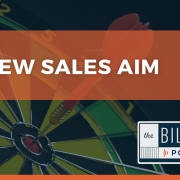How To Write Emails That Get Action
We tend to write emails in the state of ‘need’. Think about it…
- Trying to get an appointment.
- Trying to advance a deal.
- Trying to your get point across.
But that’s not a resourceful strategy.
In this video, Bill Caskey, Author of Email It — A Seller’s Guide to Emails That Work with 20 Pre-Written, Ready-to-Use Emails, gives you the framework to use for ANY email you might write to a prospect or your client.
You can learn more tips on how to write emails to a prospect or your client at: http://emailitsellersguide.com/
*VIDEO TRANSCRIPT*
Hi. Bill Caskey back at Caskey One. We wrote a book several months ago called Email It, Brooke Greene, Bryan Neale and myself; and what was happening we saw on the market is a lot of times, salespeople were relying on the written word to either get appointments to move the sale cycle along, to handle difficult situations, to connect with other referral partners, et cetera. So we took the 20 most common situations that face salespeople where they were required to write email, notes and letters and we put them into a package that actually gives you some verbatims to use.
But in this video, we’re going to talk about not each one of these individuals. We’re going to talk about a general template. We find that when you write an email, it seems like we’re always writing these things when we’re in the state of mind of, “We need something.”
- We need an appointment.
- We need a sale.
- We need the prospect to keep talking to us.
- We need the sales cycle to keep moving and so a lot of the state of mind we’re in is a needy, desperate sometimes anxious state of mind, which is exactly the wrong state of mind that you want to be in when you’re writing an email that’s going to prompt some action.
So over the years, we’ve created these and we’ve kind of come up with a template that we think is important for you to use. So we’re not going to talk specifically about any one of these although if you search around on Caskey One, there are several other videos that address some very specific issues. We’re going to talk about this in terms of the structure of the email.
So we’re going to say paragraph number one or section number one needs to be a review and what we mean by this is, “How did you get to this point?” If you’re writing to a prospect who is resisting your offer or maybe somebody down in the very 11th hour of the sales cycle, go ahead and spend a paragraph and review how you got there. You might say something like, “We’ve been working on this together for the last few months,” or “I sent you the proposal last week and I have not heard from you.” So somehow do a review. That sets the stage. It gets everybody on the same page.
Two is reveal. Now, I’m not suggesting that you do this every time you send an email but occasionally it makes some sense to reveal anything going on inside you. Like, you might reveal vulnerability. You might say something like, “I’m writing this email but I’m not very good at crafting messages like this but I did want to reach out to you and see if it would make sense for us to meet,” or you might say, “I’m a little bit uncomfortable asking this question because I know you told me when we were together two weeks ago but time has passed and I’m not sure of the exact answer.” Reveal something here. Be vulnerable. Being vulnerable taps the emotion of the prospect at a much deeper level than some kind of a form email. So as you put your personality in these emails, make sure you reveal something a little vulnerable about yourself.
Step three is, if I’m the viewer or the recipient, give me something that I can say yes or no to. Recommend a course of action. So if you want to get together with someone again or if you want to have a phone call or you want to set up a webinar or you want to send out an email with a link to a website that has a video on it, make sure you’re very clear about what you recommend. “Bob, below I’m pasting the code for a website that has a very important video that deals with your specific issue. I would like for you to watch it and I will call you in a week, next week sometime to talk about the contents of that.” So be very specific.
The more specific you are, the more likely you are to get them to take that action.
So review, reveal and recommend are three ways you can structure virtually any email that you write whether it’s a prospecting email or a connector email or whatever. I do encourage you though to buy the book Email It. It’s $20. It’s a PDF and it has some cut-and-paste verbatims in it and I’m sure that you’re going to find at least 8 or 10 or 12 email scenarios in there that you use all the time.




